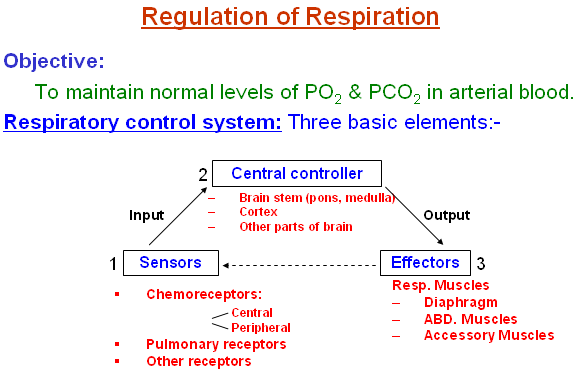Respiratory Center
Consists of:
- Brain stem (Pons & Medulla) ; Main Centre
- Cortex — Voluntary control centre.
– Voluntary Hyper ventilation.
– Breath holding
- Other parts of Brain
– Hypothalamus
– Limbic system (Rage & Fear)
- Pre- Botzinger complex located on either side of medulla
- DRGN & VRGN in medulla project to the pre- Botzinger
pacemaker neurons.
- Pre-Botzinger neurons discharge rhythmically and produce
rhythmical discharges in Phrenic nerves (respiration).
Respiratory Center in Brain Stem:
Commonly called “Respiratory Center”.
Composed of:
- Medullary respiratory center
– Dorsal respiratory group (DRG) of neurons
– Ventral respiratory group (VRG) of neurons
2.Apneustic center
3.Pneumotaxic center
Dorsal Respiratory Center:
Site: Dorsal region of Medulla
Nucleus Tractus solitarius
Role: Inspiration
Mechanism: – Intrinsic periodic firing
– Insp. ramp signals
(Inhibited by Pneumotaxic Center)
Ventral Resp. Group:
Site: 5 mm Ant & Lat. to Dorsal respiratory group of neurons.
in Nucleus ambiguus & Retro ambiguus
Role: – Quiescent during quiet breathing
– Expiration during exercise
Apneustic Center: in lower pons
– Excitation of inspiratory area.
– Prolong Insp. ramp.
Pneumotaxic Center:
Inhibits Inspiration
by “Switching off” Insp. ramp.
Chemical Control of Respiration
Objective:
To maintain proper concentration of O2, CO2 & H+ in the tissues.
Chemoreceptors:
-
- Central chemoreceptors (chemo sensitive area)
– Direct chemical control of Resp. center activity
-
- Peripheral Chemoreceptors
– Indirect chemical control of Resp. center activity
Chemosensitive Area of Resp. Centre:
• Located bilaterally less than 1 mm beneath the ventral surface of medulla.
• Highly sensitive to changes in bl. PCO2 or H+ conc.
• Excites Medullary Resp. Centre.
Stimulation of Chemosensitive Area.
H+ Ions:
Primary stimulus/only direct stimulus for the neurons of chemo sensitive area.
Changes in H+ conc. in blood actually have less effect in stimulating chemo sensitive neurons than do changes in PCO2.
because: • H+ & HCO3- cannot easily cross Blood brain barrier.
• Normal pH of cerebrospinal fluid is 7.32 Less buffering power
• Less Proteins in CSF
• CO2 is Lipid-soluble & diffuses easily
thus changes in CSF pH for given change in PCO2 is greater than that in blood.
CO2:
• Acute Effect:-
Stimulates chemo sensitive neurons indirectly;
it has very little direct effect.
“Since CO2 is lipid soluble, PCO2 in blood, immediately leads to PCO2 in CSF & brain tissue (i.e interstitial fluid or medulla)”.
thus – H+ conc. promptly rises in CSF.
• Chronic Effect:-
Decreased stimulatory effect of CO2 after 1-2 days, due to : –
i. Renal adjustment of H+
ii. Very slow diffusion of HCO3-
O2:
• No direct effect on Resp. center
Reason:-
Hb-O2 buffer system maintains almost exactly
normal amount of O2 even when pulmonary
PO2 changes from 60 mmHg to 1000 mmHg.
Peripheral Chemoreceptors:
Location: outside the brain;
In carotid bodies – Largest number
In aortic bodies – Sizable number
In other arteries of thorax
Few in abdominal region
Sensitivity:
Respond to: decrease in arterial PO2
increase in arterial pH & in arterial PCO2
Role of Art. PO2:
• No direct effect on resp. center.
• Acts through carotid bodies.
the sensitivity of receptors begin at 500 mmHg
max. sensitivity of receptors between 60-30 mmHg
Role of Art. PCO2/pH.
• Indirect effect is less important i.e. PCO2 & H+ conc.
• Stimulate central chemo directly.
• Direct effect is 7 times more powerful.
• Indirect effect is 5 times rapid.
(Important at the onset of exercise)
i.e. through carotid bodies.
In human carotid but not aortic bodies respond to fall in Art. pH
 howMed Know Yourself
howMed Know Yourself


the information provided is given in a sequence which is easy for us to refer quickly.
The given information is simplified yet comprehensive, giving a quick review of an important physiology topic.
Thanks a lot..it was really v.helpful..
what is the mechanism of change in respiration from right and left nostril every 3 hours?